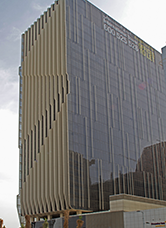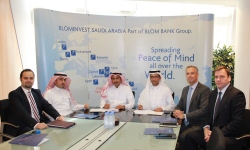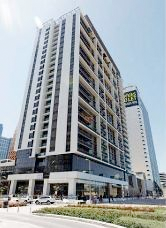Abu Dhabi: The Middle East Council for Offices has revealed the first best practice guide for any commercial buildings in the region.
In a cross-industry collaboration, a group of architects, engineers, developers, consultants and property experts have pooled their knowledge to create a best practice guide for regional commercial buildings. Under the banner of the Middle East Council
for Offices (MECO), the guide was unveiled on 16 April in Microsoft’s Dubai auditorium, in front of a packed crowd of invited industry guests.
Chaired by Chris Seymour, head of property and social infrastructure at EC Harris, MECO’s committee also includes representatives from Woods Bagot, CBRE, SinoGulf Real Estate Investments, Servcorp, Al Tayer Stocks, Hoare Lea and Black and White Engineering.
Introducing the committee, Seymour commented: “MECO prides itself on being cross discipline, covering the entire consultancy field and also the supply chain. That gives us an unbiased view and expertise.”
What were the reasons for creating the best practice guide? Co-chair Lachlan Buchanan, international property project manager at Servcorp, explained: “The Middle East is vastly different from other markets around the world – both climatically and culturally – and we thought that this region warranted a special guide that addresses best practice in the office sector.
“The guide is for everyone that has input into the lifecycle of an office building. It is geared towards new buildings. But even if you use all of the metrics in this guide, you are still not guaranteed to create a successful office building or development.”
So what is contained in this guide? According to Woods Bagot’s projects director, Richard Fenne, it is not an encyclopedia. He continued: “It’s about 15 pages long – easy to download and carry around with you. It’s a broad summary of what we feel are the key metrics within the parameters of office development.”
In the guide, a central core and a 9m planning grid are cited as a best practice. Fenne explained: “Central cores are easy to build, efficient, and all of the mechanical services are in the centre of the building. From a construction point, a 9m grid is great because you can pretty much get a flat slab when you are coordinating services.”
The guide specifies an 80% efficiency target (net to gross) for medium rise buildings. “We don’t think that’s a hard target,” added Fenne. “It gets harder the higher you get up. Over 40 storeys you are going to see the lower end of the metric – 60-75% efficiency.”
A floor plate depth of 6m to 12m from the windows to a core is recommended. “Anything over 12m and you start to get diminishing daylight. Anything less than 6m and it becomes challenging to give flexibility,” Fenne continued.
He added that flexibility is a word that often springs up. “Developers don’t know where they are going to be in six months' time, let alone five years. It’s about making sure that there’s future planning for subdivisions, or to provide additional risers.”
Representing the voice of developers, David Cockerton, fund manager at SinoGulf, reiterated that flexibility is “the name of the game”.
Yet how much flexibility should there be in an office design? Rupert Bowen Jones, agency and development for CBRE, said: “We would like to have buildings that are flexible enough to be able to move the walls around, but in a regulatory
framework that may cause a lot of problems in reality. There’s that disconnect from the guide being best practice and the regulatory realities. But that said, when developing a building, you should be making it as flexible as possible, which will help you attract more tenants. And regulation can change.”
When it comes to occupational density, the current industry standard is 10-14m2 net interior area (NIA), per person. “We think it should be more aggressive, like 8-12m2,” said Fenne. “Local organisations are still very reliant on cellular space – large offices, huge meeting spaces. But we’re seeing things shift to what we call an international standard, and a migration from cellular to open plan.”
Cockerton added: “In our experience, occupational density has probably been the most important aspect. I don’t think there are many occupiers out here that have been achieving 8 or 9 [m2 NIA per person]. It’s on the checklist but when they come to do the designs – the fit-out guys start to build the meeting rooms and the breakout spaces – it’s amazing how that occupational density goes up.”
Due to the capital costs of structure, façade and fenestration, the guide recommends keeping the slab-to-slab height as low as possible, without compromising the quality of the internal space. Fenne remarked: “We’re saying slab-to-slab of
about 4m. That will allow you a service zone of about 750mm in the ceiling void for mechanical services and lighting. We think all offices should have raised floors, for flexibility, of 150mm.” This results in an internal clear height of about 2.7-
3m, which Fenne described as “sensible” to allow a good quality of internal environment.
Of course, a big challenge in the Middle East is dealing with the climate, so the performance of the external envelope is critical. Fenne questioned the need for fully glazed buildings. “There’s more than enough daylight getting in central strip windows that will allow quality of daylight in a space. What do most developments do? The put blinds up to manage glare and keep sunlight out of the space. You’re still getting about 70% of the energy coming into the space.
“The envelope becomes critical. U-Values are important – the lower the value, the better the building is insulated. Light transmittance is important – that’s the ability to allow light to pass through the glazing. Finally, there’s solar heat gain coefficient – also known as G-value. I think this gets overlooked – it’s the ability of solar energy to pass through material.
He continued: “You can’t look at these independently – they have to be looked at as a collective. We encourage the use of energy modelling to help understand some of these parameters around façade performance and quality of daylighting.”
Fenne also pointed out that poor detailing will allow energy to pass into the building and increase cooling loads. “As an architect I put my hand up to say that we’re often culprits of this,” he said.
There are a number of passive methods which can help, according to Fenne. He added: “In the case of south-facing façades, overhangs can be combined with internal blinds to reduce energy intake by up to 75%. Just by using horizontal
louvres outside, you are keeping the sun off a building. It is the same principal for the east and west-facing façades, but you should use vertical fins instead of horizontal.”
He added that there is a prevalence of sophisticated systems using mechanical louvres which are able to move and respond to the path of the sun. “In this part of the world, anything external that’s mechanical is a challenge due to
dust and sand.”
Other recommendations include one car parking space per 50m2 of NIA, a maximum lift waiting time of 30-seconds and accessible stairs. “It’s amazing how many people will use a nice spiral staircase,” added Fenne.
Moving forwards, the committee was quick to point out that the guide is an “evolving” document and that industry feedback will help fill in any gaps. Fenne admitted there is nothing specifically on fire and life safety, which may
be considered in future issues. Buchanan also added that there is no detailed commentary on facilities management.
Buchanan is wary that many of the targets could be deemed as ‘aspirational’, yet he believes that a high bar is necessary. “Without setting lofty standards we’re not going to have an evolvement of the office market. It can only be positive to set a high bar and try and maintain that. Ultimately people function more productively in a better
office environment.”
While the creation of a best practice guide is commendable, its effectiveness will be limited by
the current lack of governmental engagement. However, EC Harris’ Seymour said that government recognition is on the agenda. “What we want to do is put it out for market soundings – an informal consultation phase – before we go to
the government and say ‘this is what the industry thinks’. Will we get a total buy in? I doubt it. The Middle East is a varied place, but what we are looking for is recognition.”
Buchanan also stated that regulation and best practice don’t necessarily go hand in hand.“One of the difficulties that we faced is that the GCC have varying building regulations, such as Estidama and the Dubai Green Building Codes. As a best practice guide it was not intended to accommodate all the various regulations.
“We haven’t ignored those building regulations, but just because something is a mandatory requirement it shouldn’t necessarily represent a best practice approach. For example, in Abu Dhabi, the maximum density that the fire regulations will allow is 9.3m2 per person. We consider best practice is anywhere between 8 and 12m2 per person.”
Yet despite the lack of government buy-in, the committee believes that the guide can have an impact. Buchanan continued: “We feel that the market is ready for a best practice guide. When you consider the growth of the market and the aspiration and sophistication that is coming in, this should be reflected in the quality of office space. That’s why we feel this guide is important. We are very proud of it and it’s been a few years in the making.”
Cockerton concluded: “It is aspirational but achievable. There are buildings here – not many – that meet various criteria in the guide. As the market develops, buildings will tick more boxes. The importance of the guide is that it is relevant
to the market, aspirational and user-friendly.”




